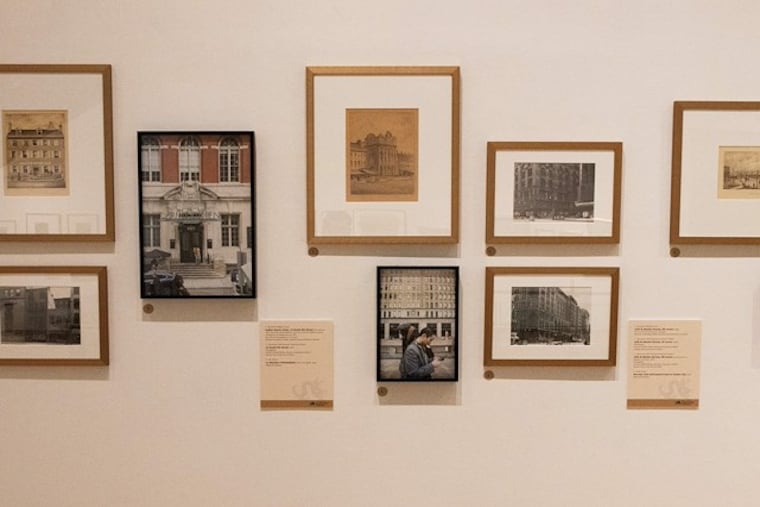Drexel mounts first display of works from Atwater Kent Museum, just as promised
'Seeing Philadelphia' brings together varied views of the city through prints, drawings, photographs, paintings, and maps from the historic collection.

In May 2022, Philadelphia Orphans’ Court authorized a transfer of ownership of the Philadelphia History Museum’s three centuries’ worth of collection to Drexel University. The artifacts, famously ranging from President George Washington’s desk to a weather vane that once twirled above Moyamensing Prison, were previously homed, for 84 years, in the city’s Atwater Kent Museum.
Now, Drexel is making good on its promise to exhibit artifacts from the collection for the public.
After making over 3,000 objects from the collection available to the public digitally on Philadelphiahistory.org, the university has announced “Seeing Philadelphia” at the Pennsylvania Academy of the Fine Arts, the first exhibition of objects from the Atwater Kent Collection.
A second one, “Philadelphia Revealed,” is scheduled to be on display at PAFA in July 2024.
“Seeing Philadelphia” brings together varied views of the city through prints, drawings, photographs, paintings, and maps from the collection. These are accompanied by photographs and writings produced through an intergenerational storytelling project called TRIPOD — all created through a collaboration between students from Drexel, Paul Robeson High School, YouthBuild Philadelphia, and older Philadelphia residents.
The result is an exhibit that is “a piece of not only Philadelphia history, but it’s also about sharing the objects and the history of the collection,” said Stacey Swigart, director of the Atwater Kent Collection at Drexel.
“We wanted to show things that haven’t been on view for a really long time,” she said.
While there are some of William Birch’s ubiquitous paintings of Philadelphia, there is also work by Benjamin Ridgway Evans. The architect/draftsman/painter lived in the city around 1857 and made hundreds of watercolors of the city’s buildings and streets.
In “Seeing Philadelphia,” those find resonance in photographs (of the same places) taken 60 years later by a federal Works Progress Administration photographer. “Here’s the evolution of different streetscapes and buildings and historic structures, which, in their day weren’t historic until they were seen again in the photography of the 1940s,” said Swigart.
Now, in 2023, these have all inspired the contemporary storytellers working with TRIPOD, whose work are also part of the exhibit.
Philadelphian Allan Randall Freelon Sr. was the first African American to be appointed art supervisor of the Philadelphia School District. His aquatints from the mid 1930s share space with an 1834 pen-and-ink Benjamin Ridgway Evans drawing of (as the inscription reads) “Broad St near Montgomery Ave.”
One painting by Arrah Lee Gaul looks up Broad Street, all the way to City Hall, making note of the flags and banners that commemorated 1926′s Sesquicentennial International Exposition. Lee Gaul, the official painter for the Sesquicentennial, was the head of the art department of what is now the Moore College of Art & Design. She was the first woman to hold a solo show at the Philadelphia Art Club. In 1980, after she passed away, The Inquirer called her “[an] intent, determined, stubborn, positive — a woman you couldn’t fool.”
The thread that connects it all for Swigart is access. She and her team are hard at work to ensure that people can keep learning and accessing the city’s history through the collection.
“Seeing Philadelphia” is not just a collection of the many ways Philadelphia has been seen in the last three centuries, but it also builds a lineage of historical “seers” — observers who have recorded the cityscapes in styles that are unique and (often) pathbreaking — not unlike many of us who use social media tools of our choice to see and record the city in angles we fancy.
There are aerial views, close zooms, as well as wide angles in color, sepia, and shades of gray in “Seeing Philadelphia.” The disparate views all come together, creating a tapestry of the city that braids the familiar with the surprising. Any way you look at it.
“Seeing Philadelphia” runs through Sept. 5. Frances M. Maguire Gallery, Pennsylvania Academy of the Fine Arts, 128 N. Broad Stt., Philadelphia. Free. http://www.philadelphiahistory.org/3814-2/